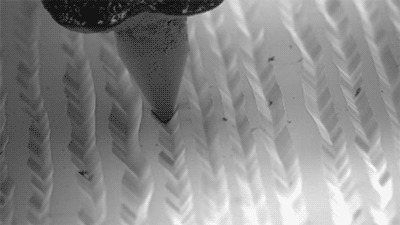Science-is-magical - Science Is Magic








More Posts from Science-is-magical and Others


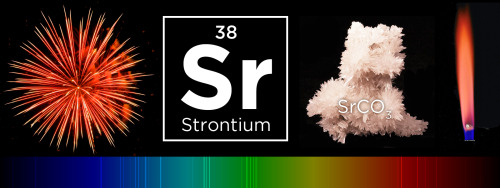
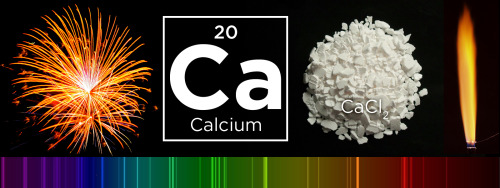
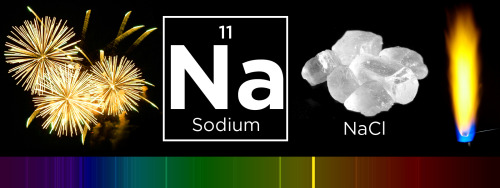
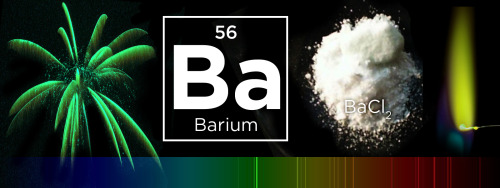
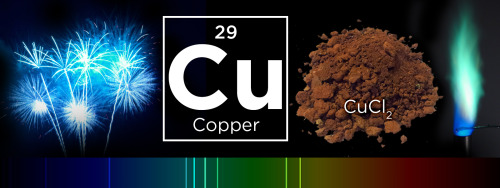
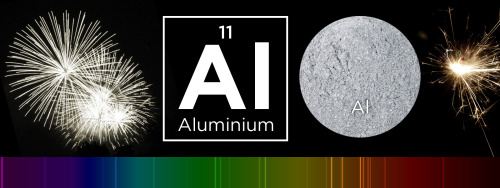
What makes fireworks colorful?
It’s all thanks to the luminescence of metals. When certain metals are heated (over a flame or in a hot explosion) their electrons jump up to a higher energy state. When those electrons fall back down, they emit specific frequencies of light - and each chemical has a unique emission spectrum.
You can see that the most prominent bands in the spectra above match the firework colors. The colors often burn brighter with the addition of an electron donor like Chlorine (Cl).
But the metals alone wouldn’t look like much. They need to be excited. Black powder (mostly nitrates like KNO3) provides oxygen for the rapid reduction of charcoal © to create a lot hot expanding gas - the BOOM. That, in turn, provides the energy for luminescence - the AWWWW.
Aluminium has a special role — it emits a bright white light … and makes sparks!
Images: Charles D. Winters, Andrew Lambert Photography / Science Source, iStockphoto, Epic Fireworks, Softyx, Mark Schellhase, Walkerma, Firetwister, Rob Lavinsky, iRocks.com, Søren Wedel Nielsen
Flying to New Heights With the Magnetospheric Multiscale Mission
A mission studying Earth’s magnetic field by flying four identical spacecraft is headed into new territory.

The Magnetospheric Multiscale mission, or MMS, has been studying the magnetic field on the side of Earth facing the sun, the day side – but now we’re focusing on something else. On February 9, MMS started the three-month-long process of shifting to a new orbit.

One key thing MMS studies is magnetic reconnection – a process that occurs when magnetic fields collide and re-align explosively into new positions. The new orbit will allow MMS to study reconnection on the night side of the Earth, farther from the sun.

Magnetic reconnection on the night side of Earth is thought to be responsible for causing the northern and southern lights.

To study the interesting regions of Earth’s magnetic field on the night side, the four MMS spacecraft are being boosted into an orbit that takes them farther from Earth than ever before. Once it reaches its final orbit, MMS will shatter its previous Guinness World Record for highest altitude fix of a GPS.
To save on fuel, the orbit is slowly adjusted over many weeks. The boost to take each spacecraft to its final orbit will happen during the first week of April.

On April 19, each spacecraft will be boosted again to raise its closest approach to Earth, called perigee. Without this step, the spacecraft would be way too close for comfort – and would actually reenter Earth’s atmosphere next winter!

The four MMS spacecraft usually fly really close together – only four miles between them – in a special pyramid formation called a tetrahedral, which allows us to examine the magnetic environment in three dimensions.

But during orbit adjustments, the pyramid shape is broken up to make sure the spacecraft have plenty of room to maneuver. Once MMS reaches its new orbit in May, the spacecraft will be realigned into their tetrahedral formation and ready to do more 3D magnetic science.

Learn more about MMS and find out what it’s like to fly a spacecraft.
dude seeing these Mega high quality images of the surface of mars that we now have has me fucked up. Like. Mars is a place. mars is a real actual place where one could hypothetically stand. It is a physical place in the universe. ITS JUST OUT THERE LOOKING LIKE UH IDK A REGULAR OLD DESERT WITH LOTS OF ROCKS BUT ITS A WHOLE OTHER PLANET?

Drone with grabbing claw arms can lift 44 pounds
Prodrone’s latest creation could lift a four-year-old child, and uses its 5-axis metal claws to perch on fences like a bird.
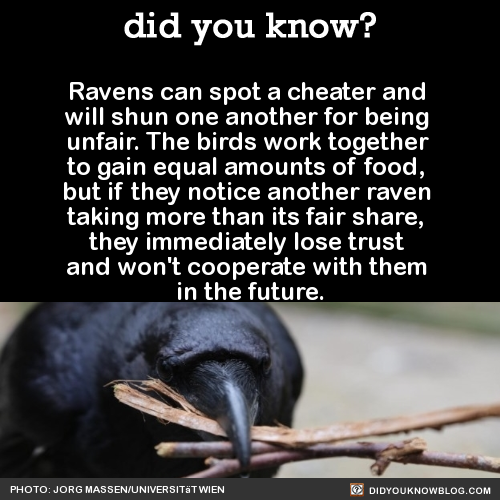
In an experiment, two ravens had to simultaneously pull the two ends of one rope to slide a platform with two pieces of cheese into reach. If only one of them pulled, the rope would slip through the loops, leaving them with no cheese. Without any training they solved the task and cooperated successfully.

However, when one of the two birds cheated and stole the reward of its companion, the victims of such cheats immediately noticed and started defecting in further trials with the same individual.

“Such a sophisticated way of keeping your partner in check has previously only been shown in humans and chimpanzees, and is a complete novelty among birds.”

Source
-
 khalif-rufai reblogged this · 4 years ago
khalif-rufai reblogged this · 4 years ago -
 aspiringneuropsychologist reblogged this · 4 years ago
aspiringneuropsychologist reblogged this · 4 years ago -
 rosefleur liked this · 4 years ago
rosefleur liked this · 4 years ago -
 retire62 liked this · 4 years ago
retire62 liked this · 4 years ago -
 pclysemia liked this · 4 years ago
pclysemia liked this · 4 years ago -
 umoreamabile liked this · 5 years ago
umoreamabile liked this · 5 years ago -
 kawcinelle reblogged this · 5 years ago
kawcinelle reblogged this · 5 years ago -
 kawcinelle liked this · 5 years ago
kawcinelle liked this · 5 years ago -
 foreverinanexistentialcrisis liked this · 5 years ago
foreverinanexistentialcrisis liked this · 5 years ago -
 oddeyemp4 liked this · 5 years ago
oddeyemp4 liked this · 5 years ago -
 studyflxwer reblogged this · 5 years ago
studyflxwer reblogged this · 5 years ago -
 jfdklaghsdkla liked this · 5 years ago
jfdklaghsdkla liked this · 5 years ago -
 hayapeko liked this · 5 years ago
hayapeko liked this · 5 years ago -
 infjfangirl02 liked this · 5 years ago
infjfangirl02 liked this · 5 years ago -
 bnuy42 liked this · 5 years ago
bnuy42 liked this · 5 years ago -
 qjisiv reblogged this · 5 years ago
qjisiv reblogged this · 5 years ago -
 jogudero reblogged this · 5 years ago
jogudero reblogged this · 5 years ago -
 drugs-dont-have-calories liked this · 5 years ago
drugs-dont-have-calories liked this · 5 years ago -
 swiftmyqueenofmyheart liked this · 5 years ago
swiftmyqueenofmyheart liked this · 5 years ago -
 stud-dee reblogged this · 5 years ago
stud-dee reblogged this · 5 years ago -
 ms-ethereal-angel reblogged this · 5 years ago
ms-ethereal-angel reblogged this · 5 years ago -
 ms-ethereal-angel liked this · 5 years ago
ms-ethereal-angel liked this · 5 years ago -
 rhysiisms liked this · 5 years ago
rhysiisms liked this · 5 years ago -
 accidentalsuixide liked this · 5 years ago
accidentalsuixide liked this · 5 years ago -
 70sjune liked this · 5 years ago
70sjune liked this · 5 years ago -
 82x12 liked this · 5 years ago
82x12 liked this · 5 years ago -
 wickedgameswastedtimes liked this · 5 years ago
wickedgameswastedtimes liked this · 5 years ago -
 mlndbodysplrlt liked this · 5 years ago
mlndbodysplrlt liked this · 5 years ago -
 k10874462 liked this · 5 years ago
k10874462 liked this · 5 years ago -
 chaosbyjes reblogged this · 5 years ago
chaosbyjes reblogged this · 5 years ago -
 chaosbyjes liked this · 5 years ago
chaosbyjes liked this · 5 years ago -
 beforesunsrisee-blog liked this · 5 years ago
beforesunsrisee-blog liked this · 5 years ago -
 bellenxx reblogged this · 6 years ago
bellenxx reblogged this · 6 years ago -
 lulumaryyy reblogged this · 6 years ago
lulumaryyy reblogged this · 6 years ago -
 lulumaryyy liked this · 6 years ago
lulumaryyy liked this · 6 years ago -
 letscandyme liked this · 6 years ago
letscandyme liked this · 6 years ago -
 homesicksapiens reblogged this · 6 years ago
homesicksapiens reblogged this · 6 years ago -
 chibureki liked this · 6 years ago
chibureki liked this · 6 years ago -
 skinnylove1713 liked this · 6 years ago
skinnylove1713 liked this · 6 years ago










